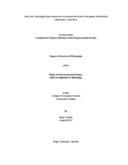Mostrar el registro sencillo del ítem
Land use, hydrological processes and ecosystem services in the upper Reventazón watershed, Costa Rica
| dc.contributor.author | Toohey, Ryan | es_ES |
| dc.date.accessioned | 2015-07-23T19:25:38Z | |
| dc.date.available | 2015-07-23T19:25:38Z | |
| dc.date.issued | 2012 | |
| dc.identifier.uri | https://repositorio.catie.ac.cr/handle/11554/7116 | |
| dc.description | Tesis (Ph. D. with emphasis in Hydrology) -- CATIE. Escuela de Posgrado, Turrialba (Costa Rica); University of Idaho, ID (Estados Unidos), 2012. | en_EN |
| dc.description.abstract | Costa Rica experienced large scale deforestation between the 1940s and 1980s. Due to the rapid loss of forest, the Costa Rican government initiated the Pagos para Servicios Ambientales, or Environmental Service Payments (ESPs), program that linked ecosystem services such as biodiversity conservation and hydrological services to forested land cover by compensating private landowners for forest preservation, regeneration, or agroforestry activities. However, the effect of land use on hydrological services and processes remains an area of active research. Within the framework of the ESPs, this research investigated: 1) understanding the regional tropical hydrology, 2) determining whether regional land uses impact soil characteristics and hydrological processes, and 3) evaluating the significance and overlap of different ecosystem services within the context of conservation planning. In the first chapter, I measured soil properties and hydrological processes within common regional land uses (forest, coffee, sugar cane and pasture) at the point, the plot, and the field scales. Macropore networks facilitated much more percolation in the forest and coffee. Compaction in the sugar and pasture diverted precipitation horizontally as surface runoff and lateral flow. In Chapter 2, I investigated whether similar results could be observed at greater scales using one-cell and watershed model simulations based on the Soil Moisture Routing model. I combined land use parameterization to investigate the interplay of antecedent moisture content (AMC), infiltration, surface runoff and percolation using a one-cell model. At this scale, a ‘fill and spill’ runoff generation mechanism was observed when precipitation intensity exceeded the different land use soil storage amounts and conductivities. The greatest differences between land uses were observed at AMC less tan field capacity where subsurface connectivity was limited within the sugar and pasture. Seven nested watersheds were classified as either forested (>85% forested) or mixed-land use watersheds (<50% forested). At the watershed scale, greater amounts of percolation occurred during the transition from the dry season to the wet season in the forested watersheds than in the mixed-land use watersheds. Also, surface runoff occurred earlier in the mixed-land use watersheds than in the forested watersheds. The connectivity between the greater percolation and greater streamflow in the forested watersheds than the mixed-land use watersheds suggests the ‘fill and spill’ type mechanism may be enhanced through greater conductivities and macropore connectivity. In Chapter 3, I modeled multiple ecosystem services of different multi-strata coffee agroforestry systems (CAFS) within the Volcánica Central de Talamanca Biological Corridor. Interviews and a Strengths, Weaknesses, Opportunities and Threats analysis, and maps of the ecosystem services were used to prioritize ecosystem services and areas for conservation activities. Current CAFS management within the VCTBC provided the greatest opportunity for preservation of hydrological and integrated pest management services. While certain CAFS regions were prioritized because of specific ecosystem services, stakeholders included location, proximity to roads and resources, and organizational infrastructure as other themes for prioritization. | es_ES |
| dc.language.iso | en | es_ES |
| dc.publisher | CATIE, Turrialba (Costa Rica) | es_ES |
| dc.subject | UTILIZACION DE LA TIERRA | |
| dc.subject | PROCESOS HIDROLOGICOS | |
| dc.subject | BALANCE HIDRICO | |
| dc.subject | PROPIEDADES FISICO-QUIMICAS | |
| dc.subject | SUELO | |
| dc.subject | CUENCAS HIDROGRAFICAS | |
| dc.subject | AGROFORESTERIA | |
| dc.subject | SERVICIOS ECOSISTEMICOS | |
| dc.subject | RIO REVENTAZON | |
| dc.subject | COSTA RICA | |
| dc.title | Land use, hydrological processes and ecosystem services in the upper Reventazón watershed, Costa Rica | es_ES |
| dc.type | Tesis de maestría | es_ES |
| dcterms.rights | acceso abierto | es_Es |
| dc.identifier.publisher | CATIE | es_ES |
| dc.identifier.publication | CATIE | es_ES |
Ficheros en el ítem
Este ítem aparece en la(s) siguiente(s) colección(ones)
-
Tesis [3111]


